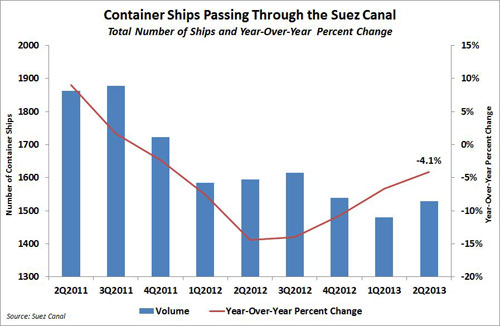The number of container ships passing through the Suez Canal experienced a drop of roughly 4 percent year-over-year in the second quarter of 2013, the smallest decline in six quarters.
The canal has seen year-over-year decreases for the past seven quarters, but the pace of the decline has slowed for the past four quarters. The Suez also saw its first quarter-to-quarter increase since the third quarter of 2012.

Container ships passing through the Suez Canal
In the second quarter of 2013, 1,528 container ships passed through the Suez Canal, 66 fewer than during the same period in 2012, according to data from the Suez Canal Authority. Container ship transits rose by 3.3 percent or 49 ships from the first quarter of 2013, the largest quarter-to-quarter increase since the second quarter of 2011. Year-to-date in 2013, the number of container ships passing through the canal has fallen 5.4 percent from the same six months in 2012, to 3,007 ships.
The total number of all ships — including general cargo, oil tankers, LNG ships, bulk carriers, combined carriers, container ships, ro-ro, and passenger ships, among others — passing through the canal in the second quarter fell 3.4 percent to 4,083 ships from 4,226 a year ago. In the first half of 2013, the number of ships passing through the Suez Canal fell 6.5 percent year-over-year to 8,012 ships.
“Egypt plays a vital role in international energy markets through the operation of the Suez Canal and Suez-Mediterranean Pipeline,” said the U.S. Energy Information Administration in a release on Friday. “In 2012, about 7 percent of all seaborne traded oil and 13 percent of liquefied natural gas traded worldwide transited through the Suez Canal. Egypt’s 2011 revolution and the unrest that has followed have not had any noticeable effect on oil and LNG transit flows through the Suez Canal or Sumed Pipeline. Changes to total oil and LNG flows through the Suez Canal in 2012 mainly occurred because of events outside of Egypt, particularly the restart of Libyan oil production and changing dynamics in LNG markets.” The first half of 2013 saw year-over-year decreases of 4.4 percent and 24.8 percent respectively in oil tankers and LNG ships.
The Journal of Commerce




.jpg)









